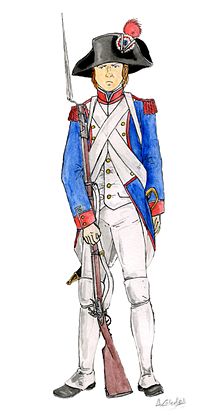| Army of the Rhine and Moselle | |
|---|---|
 Fusilier of a French Revolutionary Army | |
| Active | 20 April 1795 – 29 September 1797 |
| Disbanded | 29 September 1797 and units merged into Army of Germany |
| Country | |
| Allegiance | First Republic |
| Commanders | |
| Notable commanders | Jean-Charles Pichegru Jean Victor Marie Moreau Louis Desaix Laurent de Gouvion Saint-Cyr |
The Army of the Rhine and Moselle (French: Armée de Rhin-et-Moselle) was one of the field units of the French Revolutionary Army. It was formed on 20 April 1795 by the merger of elements of the Army of the Rhine and the Army of the Moselle.
The Army of the Rhine and Moselle participated in two principal campaigns in the War of the First Coalition. Military planners in Paris formed armies based on specific strategic tasks, and the task of this Army was to secure the French frontier at the Rhine and to penetrate the German states, potentially threatening Vienna. The unsuccessful 1795 campaign concluded with the removal of General Jean-Charles Pichegru from command. In 1796, under the command of General Jean Victor Marie Moreau, the Army was more successful. After crushing the Reichsarmee's elements at Kehl, the Army advanced into southwestern Germany.
Its success depended on the cooperation with France's Army of the Sambre and Meuse, commanded by Jean-Baptiste Jourdan. In 1796, the jealousies between Jourdan and Moreau, and among the subcommanders, complicated the efficient operations of both armies. After a summer of maneuver in which the Coalition force enticed the French deeper and deeper into German territory, the Habsburg commander Archduke Charles, Duke of Teschen drubbed the French at Wurzburg and at second Wetzlar, and then defeated Jourdan's army at the Limburg-Altenkirchen. These battles destroyed any chance that Jourdan's force and Moreau's Army of the Rhine and Moselle could merge. Once Jourdan withdrew to the west bank of the Rhine, Charles could focus his attention on Moreau. By October they were fighting on the western slope of the Black Forest, and by December Charles had the French forces under siege at the principal river crossings of Kehl and Hüningen. By early 1797 the French had relinquished control of the bridgeheads over the Rhine. After an abbreviated German campaign in 1797, the French and Austrians agreed to the Treaty of Campo Formio and, on 29 September 1797, the Army of the Rhine and Moselle merged with the Army of the Sambre and Meuse to form the Army of Germany.
The Army of the Rhine and Moselle campaigns provided experience for a cadre of young officers. In his five-volume analysis of the Revolutionary Armies, Ramsey Weston Phipps called the Army of the Rhine and Moselle a "school for marshals", to emphasize the importance of experience under these conditions in training the future leadership of Napoleon's army.